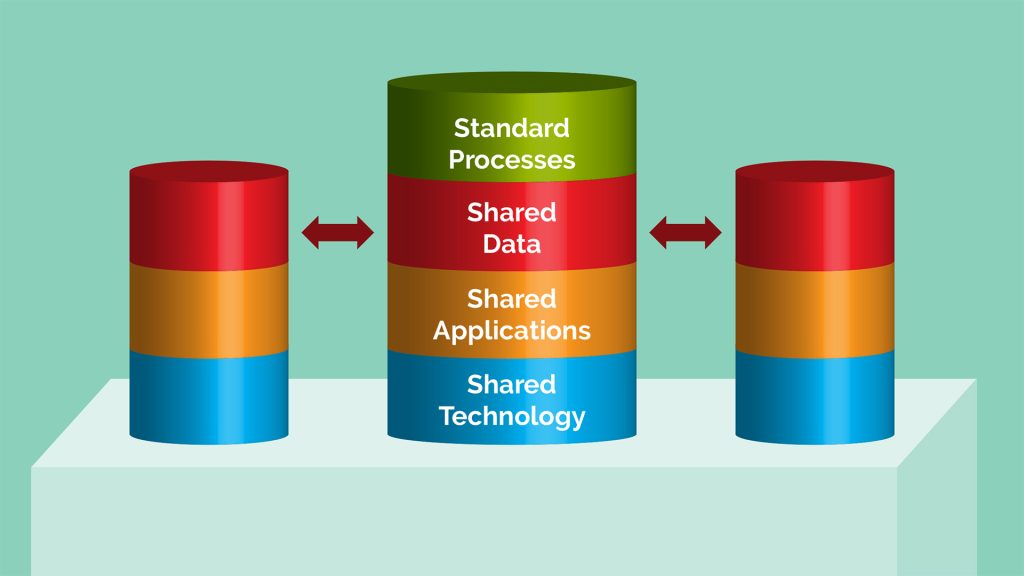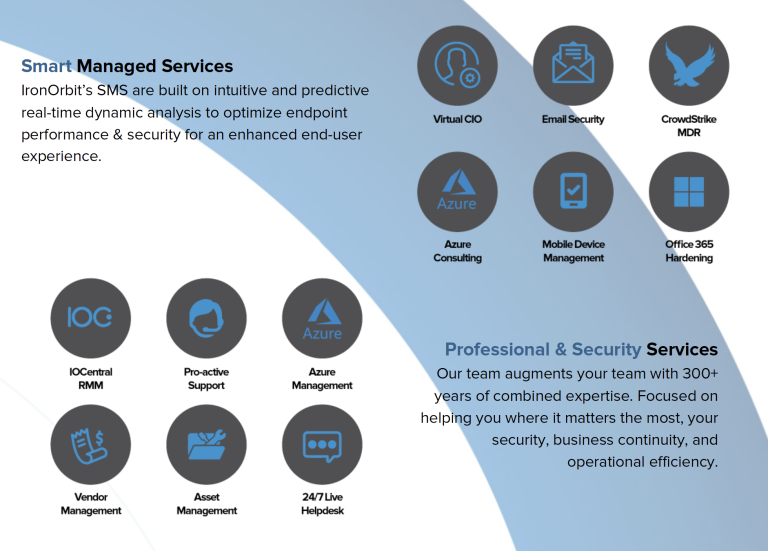BECOMING DIGITAL IS BUILT ON AN OPERATIONAL BACKBONE
Since the operational backbone is the foundation for everything else that will be developed, built, and offered to your customers, it’s important to get it right from the design stage. That’s why regrouping with your people and process is so fundamental to the process. DESIGNED FOR DIGITAL points out that although companies have been engaged, in one way or another, with digitization (remember: digitizing does not equal digital) transformation since the late 1990s, the majority of them did not have operational backbones to support their digital transformation.
The story of Intel’s dramatic digital transformation presents a good example of starting with the business needs in mind. Use the collective input of the organization to determine where exactly the business is headed. Talk to the people in the company. Talk to your customers. Strive to get an accurate big picture of your company based on facts, insight, and impressions from your customers.
Shesha Krishnapura’s, a chief technology officer at Intel, wrote an article THE ANATOMY OF INTEL’S DIGITAL TRANSFORMATION, where he explains how lines of communication between Intel’s many business units helped shape the new operating business model.
“When we look at new technologies, we investigate what it will take to transition from legacy approaches to the new ones. We look at our affordability targets and determine which one gives us the highest return on investment. One area of technology that is crucial to Intel’s digital transformation is a hybrid cloud. It is the next step in a natural evolution that started with everyone having their workstation and locally stored data. Eventually, virtual clients came along, with applications and data stored centrally (but on-premises). Now hyper-scale computing, or high-performance computing, is the trend, where a lot of computational jobs can be done in a very short amount of time using a significant amount of fungible computing capacity. But on-premises capacity can reach a saturated utilization, and enterprises need burst capacity. The ability to seamlessly move workloads between private and public clouds—i.e., a hybrid cloud—is the answer.”

An operational backbone is a coherent set of enterprise systems, data, and processes supporting a company’s core operations.
Although an operational backbone is a digital building block for becoming a digital company, it is not something that is etched in stone. Far from it. Because a business changes, an operational backbone is never complete. Technology changes, and you may discover through analyzing customer data, that their needs have changed. So your operational backbone has to be designed in such a way that it continuously evolves to meet the situation as it evolves. All the components that make up your operational backbone have to be agile and flexible as well. If any aspect of it has limitations or rigid parameters, it’s going to gum up the works. Like clogging up an artery, it could cause paralysis or worse.
Invest in an Operational Backbone and a Digital Platform to Secure Efficiency & Revenue Growth
Having done the work to assemble an operational backbone, you’ll have set in motion the ways and means to create a digital platform. Properly designed, this platform will enable quick and easy access to data, configure, and reconfigure business processes, and technology components to generate and enhance digital offerings. At the base of this platform is a repository of cloud services. Depending on the specific demands and needs of your company, this might be a public, private, or hybrid cloud environment. Whatever the architecture happens to be, make sure it is flexible enough to adapt as you need the rest of the platform to adapt.
Let’s take a moment to discuss the cloud service component. Cloud services provide the foundation. It is the basis for everything else that follows. Trevor Clohessy, Thomas Acton, and Lorraine Morgan’s 2017 paper THE IMPACT OF CLOUD-BASED DIGITAL TRANSFORMATION ON ICT SERVICE PROVIDERS’ STRATEGIES found that cloud-based digital transformation positively impacted the realization of strategic objectives such as agility and competitive positioning.
DESIGNED FOR DIGITAL (MIT Press) describes a digital platform as 3 repositories built on a base of cloud technologies. The book states that cloud services are “fairly standard across all vendors.” While that statement is true, it’s important to know that not all cloud designs are equal just as not all strategies are equal. The best ones take in the big picture of where the company is at present and where it wants to be in 5 years….in 10 years. In the context of cloud computing, a strategy can be defined as a “set of decisions required to create and deploy a network-based, information service delivery strategy that results in both cost savings and organizational agility.
The Competitive Imperative of Digital Transformation
In a 2018 Forbes article titled “Cloud Computing Comes of Age as the Foundation for Enterprise Digital Transformation” author David Bartoletti makes the following statement:
“Cloud is no longer a place to get some cheap servers or storage. It’s not even a single place. Cloud computing is now shorthand for how companies turn amazing ideas into winning software — faster. Nearly 60% of North American enterprises now rely on public cloud platforms, five times the percentage that did just five years ago.”
It has been two years since that Forbes article was written. What’s happened since then?
COVID-19
Businesses have to utilize cloud technology to keep pace with competing organizations. Some form of digital transformation has become a “must-have” for companies worldwide. But is a public cloud the right platform for your digital transformation efforts?
Today, privacy/security concerns take center stage and have businesses large and small thinking seriously about a move to private cloud.
Private cloud architecture outpaces public cloud offerings in:
- Migration
- Management
- Support
- Cost
- RTO/RPO
- Contracts
- Availability
- Monitoring
- Performance
So why do companies still choose public cloud services for their digital transformation efforts? Perhaps it is name recognition. Everyone knows about Amazon, Microsoft, and Google.
But let’s face it. Not everyone TRUSTS Amazon, Microsoft, and Google. That’s why CEOs and CIOs lean more heavily toward private cloud companies that provide a higher level of service, customization, and privacy.
There are other considerations when looking at the quality of your cloud environment. To find the summum bonum of cloud services, take a holistic approach that involves the answering several questions. What is the quality of the connection like? How good is the security of its data centers? How responsive is its level of customer service? How much control will you have over your ICT environment, and how adaptable will it be to the shifting needs of your company? These are important questions to consider.
Once company leaders grasp the concept of digital for operational and market flexibility, they begin to envision the unlimited possibilities of digital transformation.
Leading Digital Transformation
Often lost in the digital transformation conversation is the “how” of leadership throughout the process. While this may seem rudimentary, those business leaders that choose not to see digital transformation as a completely new game are often taken by surprise as the entire effort crashes and burns like the Hindenburg.
The leadership mindset of digital transformation.
Listening to the Technology Experts – But Not Too Much
IT specialists are in the business because they love what technology can do. They see the potential within technology to help you become more competitive, efficient, and cost-effective. They will have deep, valuable insight into the “how” of the project. But sometimes, because the focus of your IT department is on IT, the process can get mired in the weeds of the technology, resulting in the people and processes being left behind. It’s the task of the leadership to ensure that the strategy embraces the input of all stakeholders and ensures that the technology solves people and process challenges – not just IT issues.
Holistic Approach
Many CEOs see digital transformation as “something that the CIO and the tech department does.” Nothing could be further from the truth. The IT organization within your company will play a significant role in the deployment of the strategy, but if there isn’t a comprehensive, “all-of-business” approach in the planning stages, the effort will crumble. Why? Because anything less than a holistic approach to digital transformation results in siloed data and unproductive activity. Simply dropping cloud-based applications or infrastructure into the mix without integrating everything around the digital transformation strategy is like trying to run a NASCAR without a steering rack and transmission. Sure, you’ve got lots of power, but you’re not going anywhere fast.
Long-Haul – Iterative Process
If your company is going to be flexible and nimble enough to stay ahead in our current global economy, you’re going to have to embrace the fact that the task of digitization and digital optimization is never complete. New technologies are coming on the market every day. Not all new technologies are good, but if you’re not careful, your competitors will leverage a technology you’ve dismissed and pull the rug out from under you. To avoid this catastrophe, it’s important to view digital transformation as an ongoing activity, just like marketing, sales, and production. As they emerge, new digital technologies will allow you to work smarter, serve your customers better, and meet market challenges head-on.
Communications
With the USA still feeling the “outsourcing” effects of NAFTA, there is a continuous worry in the minds of employees about losing their jobs to cheaper labor and better technology. Part of your work as a CEO has to include boosting morale by assuring your employees that the digital transformation process is about securing their jobs into the future. It’s not about replacing them or eliminating their positions.
Company Culture
The positive potential impact of digital transformation on company culture cannot be understated. Digitization allows for a higher level of transparency, communications, and collaboration. Digital optimization can make everyone’s workday easier.
However, organizational leadership has to communicate and model the benefits, or the new strategy will be misunderstood and may even be resented by the employees.
Digital transformations are slow because it means changing habits and culture. It takes time and a concerted effort. It should be a slow process. People need the time to adjust to new processes and adopt new technologies. The need time to learn how to think and function as a digital business. Begin the journey by creating an operational backbone. Optimize so that you’re doing the same things you’ve always done, but now only better. Then you can build a digital platform. You’ll discover along the way that you will begin to accumulate a portfolio of components. These components will feed innovation and become useful in future digital offerings.

If you want to succeed, accumulate lots of components and apply plenty of imagination in using them to create new value propositions.
As Jeanne Ross points out in her book, componentization is key to becoming a fully digital company able to offer new digital value propositions to customers. To illustrate the point, she uses the plotline from the LEGO movie.
In the LEGO movie, a noble construction worker sets out to save the world from a tyrant who intends to glue in place all of LEGO world. Emmet, the construction worker, prevails, of course, because he teams up with bad guys who apply their combined creativity to outsmart the bad guys. The Key to their success is the ability to reconfigure LEGO components into whatever machine they need to overcome each obstacle they meet.
In the same way, digital companies build and adapt using whatever components they have. It all comes down to how creative and innovative they can be in assembling those solutions from parts that already exist. The challenge is to keep track of all the components so you can grab the one you need when you need it. That’s why you need a digital platform.
DIGITAL OFFERING BUILT ON A DIGITAL PLATFORM
A good example of how having a digital platform can facilitate responding to a unique situation is the Toyota Hawaii story. Toyota Motors North America responded to a particular challenge in Honolulu —a city full of condos and people but few parking spots. They came up with a digital offering called Hui—a round-trip, station-based car-sharing program that allows customers to reserve a car by the hour, or by the day, through a mobile app that also locks, unlocks, and starts the vehicle.
IN CONCLUSION
Business leaders are looking for ways to get ahead of the situation. Companies are looking at ways of improving what they already do by digitizing their processes.
The messaging around digitizing operations has to be coherent and consistent throughout all layers of the organization.
Why?
Because people don’t like change.
Digitizing, done correctly, creates a company atmosphere of constant and never-ending improvement, and that can be unsettling for some.
Securing an operational backbone this way makes sense and it should be done.
But long-term sustainable success is dependent on developing digital business capabilities where your value proposition provides a new way to solve your customer’s problem.
Make the time now to start learning how to componentize offerings, as Jeanne Ross puts it, and build a digital platform. Designing, building, and using a digital platform requires a whole new way of thinking. Even if you’re an established company, everyone must abandon old habits and, in many ways, adopt the mindset of a start-up. Companies need to get started on their digital journey now because it is going to take a while. If they wait until they have an urgent need to suddenly offer a digital solution, they won’t be able to. It will be too late.














